A Rising Role for Decentralized Solar Minigrids in Integrated Rural Electrification Planning? Large-Scale, Least-Cost, and Customer-Wise Design of Grid and Off-Grid Supply Systems in Uganda
Abstract
:1. Introduction and State of the Art
2. Methodology
2.1. Minigrids, Standalone Systems, and Network Extension Design: Compared Cost of Supply
- Network extension from the national distribution grid, including the Medium Voltage (MV) and Low Voltage (LV) technical and economic network catalog of components, the applicable grid code, and the cost of energy taken from the grid and its reliability of supply;
- Off-grid minigrids including generation and network design;
- Standalone systems, either fully-fledged Alternating Current (AC) solar systems or Direct Current (DC) solar kits.
2.2. Description of the Data Gathering Process
- The study has used existing field data from canvasses developed by GIZ and our tools for satellite imagery processing to overcome the lack of information about the precise location of electrified vs. non-electrified customers.
- Existing distribution feeders (MV): The MEMD provided a shapefile of the layout of the MV network within the Southern Service Territory of Uganda. The network file was closely analyzed to differentiate between existing and planned lines. On top of this layout, we added the respective voltage level and the energy cost at the distribution feeders. To characterize the frequent blackouts and weak supply in rural areas in Uganda, we included the reliability of each section of the network.
- Energy resources: The model considers the typical hourly solar irradiance in the SST through a year, using the National Renewable Energy Laboratory’s PVWatts® tool [58] to inform better the possible generation capacity of solar resources, taking into account seasonality, weather and temperature conditions. Additionally, we used an average cost of diesel fuel within the SST for the various minigrids designed. We assumed that the solar resource and the cost of diesel fuel were uniform throughout the SST.
- Network and minigrid generation catalog: Electrification technologies, including network equipment, such as distribution lines and transformers, PV panels, diesel generators, storage, and power conversion equipment, all have costs and quality specifications that may vary by region. For this study, we have considered mainstream available and affordable components in the region, averaging the expected evolution of their costs until 2030, especially in rapidly evolving technologies such as batteries or solar (We have not considered the emergence of future disruptive technologies, especially anticipated in batteries [59] and solar PV [60,61] for this study. Being a low-margin market, before entering the off-grid sector in developing countries, these technologies will need to mature and become widely available at a low cost).
2.3. Building Identification and Electrification Status Estimation
2.4. Existing Distribution Network (MV and LV) Infrastructure
2.5. Off-Grid Generation Catalog and Hybrid PV-Battery-Diesel Design Optimization
2.6. Topographical Restrictions
2.7. Customers Demand Characterization and Quality of Service Targets
3. Least-Cost Integrated Electrification Plan for the Southern Service Territory: Reference Scenario
3.1. Description of the Reference Scenario
- Grid Extension:
- ○
- Cost of energy purchased from the grid is USD 0.072/kWh.
- ○
- Central reliability: 90%.
- ○
- Cost of network investment, operation, preventive, and corrective maintenance, according to the catalog and standards specified by the MEMD.
- ○
- Other supply costs: Connection, protections, and meters.
- ○
- Administrative costs: billing, fee collection overhead costs incurred by the distribution company: USD 9/year.
- ○
- Discount rate: 10%.
- Minigrids:
- ○
- Cost of distributed generation: PV panels, gen-set, electronics, installation, fuel, operation, and maintenance.
- ○
- Cost of minigrid network, also including investment, operation, preventive, and corrective maintenance.
- ○
- Other supply costs: connections, protections, meters, billing, and others);
- ○
- Administrative costs: Medium size minigrid (250 customers): USD 16/year; large size minigrid asymptote at USD 9/year.
- ○
- Minimum size allowed: 50 customers.
- ○
- Discount rate: 10%.
- Stand-Alone Systems:
- ○
- Cost of purchase of DC Solar Kits, USD 290/solar kit, for loads under 150 Wp. 90 Wp PV, 44 Ah—11.1 V battery.
- ○
- Lifetime: 7 years.
- ○
- Administrative cost: USD 12/year.
- ○
- Discount rate: 15%.
- Other parameters:
- ○
- Social cost of non-served energy. USD 0.75/kWh for critical demand not satisfied and solar kits. USD 0.30/kWh for non-critical demand.
- ○
- Algorithm: Grid extension decision taken at customer (building) level, exhaustive configuration, meaning all alternative electrification modes considered for every cluster or buildings inside a cluster.
3.2. Reference Scenario Results
4. The Role of Minigrids in the Universal Access Least-Cost Reference Scenario
4.1. Determining the Minigrid/Grid-Extension Frontier
4.2. MiniGrid Portfolio: Break down of the Cost of Service, Investment, and Implementation Pipeline
5. Sensitivity Analysis
5.1. Assessment of the Impact of the Reliability of the Existing Grid
- (a)
- Reference Scenario, described in the previous section, assumes that some upstream investments in generation expansion, transmission, and distribution grid reinforcements happen, so reliability reaches 90% in this rural territory;
- (b)
- (c)
- 97% Grid Reliability Scenario analyzes what would be the least-cost solution in case upstream investments in the Southern Service Territory manage to get close to total reliability in 2030;
- (d)
- The average reliability of the minigrids supply in these scenarios remains constant at 98.7% since all the scenarios have the same demand profiles, critical and non-critical periods and uses, and the same catalog of generation components.
5.2. Assessment of the Impact of a Higher Demand Forecast
5.3. Least-Cost Reference Scenario vs. 100% Grid Extension Scenario
6. Discussion and Conclusions
- Minigrids can be several times cheaper than grid extensions, even when they are not too far from the grid. The main drivers for minigrid cost competitiveness are grid reliability, distance to the grid, distance between customers, and low aggregated demand;
- Large numbers of close-by customers and the existence of anchor loads, as large industrial customers, may justify the extension of the main network over large distances;
- Even if the cost difference is not significant, minigrids can play a transitory role as demand grows enough to make the grid connection cost-efficient;
- Grid-compatible minigrids will facilitate the transition between grid and off-grid supply, guaranteeing the permanence of the assets when the grid arrives. Regulatory provisions must be considered to enable this process.
Author Contributions
Funding
Data Availability Statement
Acknowledgments
Conflicts of Interest
Appendix A. REM Input Data Catalog
Appendix A.1. Network Catalog
| Name | Resistance [ohm/km] | Reactance [ohm/km] | Rated Current [A] | Av. Failure Rate [Failures/(km*a)] | Overnight Cost [USD] | Predictive Maintenance Cost [USD/(Year*km] | Corrective Maintenance Cost [USD/Failure] |
|---|---|---|---|---|---|---|---|
| UG_LV1 | 0.67 | 0.20 | 185.00 | 0.133 | 14,000 | 2.8 | 427 |
| UG_LV2 | 0.35 | 0.18 | 317.00 | 0.133 | 15,100 | 2.8 | 427 |
| Name | Resistance [ohm/km] | Reactance [ohm/km] | Rated Current [A] | Av. Failure Rate [Failures/(km*a)] | Overnight Cost [USD] | Predictive Maintenance Cost [USD/(Year*km] | Corrective Maintenance Cost [USD/Failure] |
|---|---|---|---|---|---|---|---|
| UG_MV1 | 0.67 | 0.25 | 185.00 | 0.133 | 26,000 | 700 | 900 |
| UG_MV2 | 0.29 | 0.23 | 317.00 | 0.133 | 28,000 | 700 | 900 |
| Name | Installed Power (kVA) | MV Voltage | No-Load Losses (kW) | Short Circuit Resistance on the Low Voltage Side (ohms) | Av. Failure Rate [Failures/a] | Overnight Cost [USD] | Predictive Maintenance Cost [USD/Year] | Corrective Maintenance Cost [USD/Failure] |
|---|---|---|---|---|---|---|---|---|
| CTI1_VUG | 25 | 33 | 0.09 | 0.06 | 1.2691 | 4799 | 80.20364752 | 25.80465181 |
| CTI2_VUG | 50 | 33 | 0.135 | 0.034 | 1.87164361 | 5899 | 80.20364752 | 25.80465181 |
| CTI3_VUG | 100 | 33 | 0.295 | 0.020 | 2.13133124 | 7246 | 80.20364752 | 25.80465181 |
Appendix A.2. Additional Parameters for the Reference Scenario
- Cost of wholesale energy for distribution:0.072 USD/kWh
- Cost of non-served energy for critical uses and solar kits: 0.75 USD/kWh
- Cost of non-served energy for non-critical uses RCS: 0.30 USD/kWh
- Discount rate for Grid Extension: 10%
- Discount rate on Minigrids: 10%
- Discount rate on Stand-Alone Systems: 15%
- Years of useful life for distribution network: 40 years
- Years of useful life for minigrids network: 40 years (grid-compatible)
- Maximum voltage drop at MV network: 10%
- Maximum voltage drop at end LV customer: 6%
- O&M Labor cost: USD 1.5/hr
Appendix A.3. Generation Catalog
| Size (kW) | Cost (USD) | Life (Years) | Installation Costs as Fraction of Panel Cost | Annual O&M as a Fraction of Panel Cost | Annual O&M Man-Hours | Annual Capacity Loss (p.u.) |
|---|---|---|---|---|---|---|
| 0.02 | 10 | 25 | 1 | 0.01 | 5 | 0.007 |
| 0.3 | 120 | 25 | 1 | 0.01 | 5 | 0.008 |
| Battery Name | Cost [USD] | Energy [kWh] | Lifetime Throughput [kWh] | SOC (min) | Capacity at End of Life (Fraction of Nameplate Energy Capacity) | Installation Costs as Fraction of Battery Cost | Annual O&M as a Fraction of Battery Cost | Annual O&M Man-Hours |
|---|---|---|---|---|---|---|---|---|
| Li-Ion Large | 1,150 | 8.6 | 17,000 | 0.2 | 0.8 | 1 | 0.01 | 5 |
| Li-Ion Small | 20 | 0.1 | 200 | 0.1 | 0.8 | 1 | 0.01 | 5 |
- Only solar minigrids have been considered for the Reference Scenario
- Lifetime [years]: 15
- Efficiency [p.u.]: 0.95
- Installation costs as a fraction of charge controller cost: 0.1
- Annual O&M as a fraction of charge controller cost: 0.01
- Annual O&M man-hours: 2
| Costs (USD/kW) | 481 | 375 | 283 | 215 | 133 | 131 |
| Sizes (kW) | 0.054 | 0.12 | 0.24 | 1.44 | 3.84 | 4.128 |
- Lifetime [years]: 15
- Inverter efficiency [p.u.]: 0.95
- Rectifier efficiency [p.u.]: 0.9
- Installation costs as a fraction of charge controller cost: 0.1
- Annual O&M as a fraction of charge controller cost: 0.01
- Annual O&M man-hours: 2
| Costs (USD/kW) | 927 | 740 | 600 | 500 | 465 | 460 | 450 | 440 | 430 | 420 |
| Sizes (kW) | 0.15 | 0.2 | 0.25 | 0.3 | 1 | 1.5 | 5 | 6 | 10 | 11.4 |
References
- The Republic of Uganda. Ministry of Energy and Mineral Development. National Electrification Strategy for Uganda; Final Strategy Paper; Ministry of Energy and Mineral Development: Kampala, Uganda, 2021; p. 74.
- Uganda Off-Grid Energy Market Accelerator UOMA. Off-Grid Energy in Uganda Market Map Market Map 2021: Foreword by the Ministry of Energy and Mineral Development; Uganda Off-Grid Energy Market Accelerator: Kampala, Uganda, 2021; Available online: https://uoma.ug/wp-content/uploads/2021/12/2021-UOMA-market-map-vFinal.pdf (accessed on 9 January 2022).
- Innovation Energie Developpement. GEOSIM Projects. 2018. Available online: http://www.geosim.fr/index.php?page=references-en (accessed on 29 April 2018).
- Ciller, P.; Ellman, D.; Vergara, C.; Gonzalez-Garcia, A.; Lee, S.J.; Drouin, C.; Brusnahan, M.; Borofsky, Y.; Mateo, C.; Amatya, R.; et al. Optimal Electrification Planning Incorporating On- And Off-Grid Technologies. A Reference Electrification Model (REM). Proc. IEEE 2019, 107, 1872–1905. [Google Scholar] [CrossRef]
- Gonzalez-Garcıa, A.; Ciller Cutillas, P.; Lee, S.J.; Palacios, R.; Cotterman, T.; Amatya, R.; Perez-Lopez, D.; Kakooza, M.; Wearne, A.; Stoner, R.; et al. Promotion of Mini-Grids for Rural Electrification in Uganda; Working Paper WP-IIT 20-184A; Instituto de Investigación Tecnológica, Universidad Pontificia Comillas: Madrid, Spain, 2018; Available online: https://www.iit.comillas.edu/publicacion/working_paper/es/423/Promotion_of_mini-grids_for_rural_electrification_in_Uganda (accessed on 4 April 2018).
- UNDP. Sustainable Development Goals; UNDP: New York, NY, USA, 2015; Available online: https://sustainabledevelopment.un.org/post2015/transformingourworld/publication (accessed on 18 April 2022).
- ESMAP; World Bank; IEA. SE4All Global Tracking Framework; ESMAP/World Bank/IEA: Washington, DC, USA, 2013; Available online: https://www.researchgate.net/publication/281354592_Sustainable_Energy_for_All_Global_Tracking_Framework_2013#fullTextFileContent (accessed on 18 April 2022).
- IEA; IRENA; UNSD; World Bank; WHO. Tracking SDG7. The Energy Progress Report 2021; World Bank: Washington, DC, USA, 2021; Available online: https://trackingsdg7.esmap.org/data/files/download-documents/2021_tracking_sdg7_report.pdf (accessed on 15 June 2021).
- Pueyo, A.; González, F.; Dent, C.; DeMartino, S. The Evidence of Benefits for Poor People of Increased Renewable Electricity Capacity: Literature Review; Institute for Development Studies Evidence Report 31. Pro-Poor Electricity Provision; IDS: Brighton, UK, 2013. [Google Scholar]
- Hutton, G.; Rehfuess, E.; Tediosi, F.; Weiss, S. Evaluation of the Costs and Benefits of Household Energy and Health Interventions at Global and Regional Levels; World Health Organization: Geneva, Switzerland, 2006; Available online: https://www.who.int/publications/i/item/9789241594790 (accessed on 18 April 2022).
- Bensch, G.; Kluve, J.; Peters, J. Impacts of rural electrification in Rwanda. J. Dev. Eff. 2011, 3, 567–588. [Google Scholar] [CrossRef]
- Colombo, E.; Romeo, F.; Mattarolo, L.; Barbieri, J.; Morazzo, M. An impact evaluation framework based on sustainable livelihoods for energy development projects: An application to Ethiopia. Energy Res. Soc. Sci. 2018, 39, 78–92. [Google Scholar] [CrossRef]
- Sovacool, B.K. Deploying off-grid technology to eradicate energy poverty. Science 2012, 338, 47–48. [Google Scholar] [CrossRef]
- Energy Access Targets Working Group. More than a Lightbulb: Five Recommendations to Make Modern Energy Access Meaningful for People and Prosperity; Energy Access Targets Working Group: Washington, DC, USA, 2016; Available online: http://www.cgdev.org/publication/more-than-lightbulb-recommendations-modern-energy-meaningful (accessed on 18 April 2022).
- Gaunt, C.T. Meeting electrification’s social objectives in South Africa, and implications for developing countries. Energy Policy 2005, 33, 1309–1317. Available online: http://www.sciencedirect.com/science/article/pii/S0301421503003756 (accessed on 7 January 2014). [CrossRef]
- Nussbaumer, P.; Nerini, F.F.; Onyeji, I.; Howells, M. Global insights based on the multidimensional energy poverty index (MEPI). Sustainability 2013, 5, 2060–2076. [Google Scholar] [CrossRef] [Green Version]
- Khandker, S.R.; Samad, H.A.; Ali, R.; Barnes, D.F. Who Benefits Most from Rural Electrification? Evidence in India: Policy Research Working Papers. Energy J. 2014, 35, 75–96. Available online: http://elibrary.worldbank.org/doi/book/10.1596/1813-9450-6095 (accessed on 22 April 2014). [CrossRef] [Green Version]
- Lee, S.J.; Sanchez, E.; Gonzalez-Garcıa, A.; Ciller, P.; Duenas, P.; Taneja, J.; de Cuadra García, F.; Lumbreras, J.; Daly, H.; Stoner, R.; et al. Investigating the Necessity of Demand Characterization and Stimulation for Geospatial Electrification Planning in Developing Countries. In A MIT Center for Energy and Environmental Policy Research Working Paper; MIT: Cambridge, MA, USA, 2019; Available online: https://www.researchgate.net/publication/335662906_Investigating_the_Necessity_of_Demand_Characterization_and_Stimulation_for_Geospatial_Electrification_Planning_in_Developing_Countries (accessed on 18 April 2022).
- Arriaga, J.I.P. Tecnologías Para el Desarrollo Humano de las Comunidades Rurales Aisladas; Real Academia de Ingeniería, Madrid, Spain: 2012. Available online: http://www.casadellibro.com/libro-tecnologias-para-el-desarrollo-humano-de-las-comunidades-rurales-aisladas/9788495662446/1967038 (accessed on 12 March 2016).
- Peters, J.; Sievert, M. Impacts of rural electrification revisited—The African context. J. Dev. Eff. 2016, 8, 327–345. [Google Scholar] [CrossRef] [Green Version]
- Dinkelman, T. The effects of rural electrification on employment: New evidence from South Africa. Am. Econ. Rev. 2011, 101, 3078–3108. [Google Scholar] [CrossRef] [Green Version]
- Bhattacharyya, S.C.; Palit, D. A critical review of literature on the nexus between central grid and off-grid solutions for expanding access to electricity in {Sub}-{Saharan} {Africa} and {South} {Asia}. Renew. Sustain. Energy Rev. 2021, 141, 110792. Available online: https://linkinghub.elsevier.com/retrieve/pii/S1364032121000873 (accessed on 2 June 2021). [CrossRef]
- González García, A.; Pérez Arriaga, I. Sistemas integrados de suministro eléctrico aislado y conectado a la red: Innovación y gobernanza organizativa para el acceso universal. Econ. Ind. 2018, 101–112. Available online: https://repositorio.comillas.edu/xmlui/handle/11531/27501 (accessed on 18 April 2022).
- Come Zebra, E.I.; van der Windt, H.J.; Nhumaio, G.; Faaij, A.P.C. A review of hybrid renewable energy systems in mini-grids for off-grid electrification in developing countries. Renew. Sustain. Energy Rev. 2021, 144, 111036. [Google Scholar] [CrossRef]
- Peters, J.; Sievert, M.; Toman, M.A. Rural electrification through mini-grids: Challenges ahead. Energy Policy 2019, 132, 27–31. [Google Scholar] [CrossRef] [Green Version]
- Pérez-Arriaga, I.J.; Stoner, R.; Rahnama, R.; Lee, S.J.; Jacquot, G.; González-García, A.; Amatya, R.; Brusnahan, M.; Dueñas, P. A Utility Approach to Accelerate Universal Electricity Access in Less Developed Countries: A Regulatory Proposal; WP-IIT-18-010A; Instituto de Investigación Tecnológica, Universidad Pontificia Comillas: Madrid, Spain, 2018. [Google Scholar]
- Alliance for Rural Electrification and USAID. Hybrid Mini-Grids for Rural Electrification: Lessons Learned; Alliance for Rural Electrification and USAID: Brussels, Belgium, 2011.
- Bhattacharyya, S.C. Mini-grids for the base of the pyramid market: A critical review. Energies 2018, 11, 813. [Google Scholar] [CrossRef] [Green Version]
- Alam, M.; Bhattacharyya, S. Decentralized Renewable Hybrid Mini-Grids for Sustainable Electrification of the Off-Grid Coastal Areas of Bangladesh. Energies 2016, 9, 268. Available online: https://www.mdpi.com/1996-1073/9/4/268 (accessed on 10 November 2016). [CrossRef] [Green Version]
- INENSUS. Clean Energy Mini-Grid Policy. Fast Tracking Rural Electrification through Accelerated and Precise Mini-Grid Policy Formulation; INENSUS: Vienna, Austria, 2020; Available online: https://www.unido.org/sites/default/files/files/2021-03/CEMG_Development_Guide_EN.pdf (accessed on 9 January 2022).
- Moner-Girona, M.; Bódis, K.; Huld, T.; Kougias, I.; Szabó, S. Universal access to electricity in Burkina Faso: Scaling-up renewable energy technologies. Environ. Res. Lett. 2016, 11. [Google Scholar] [CrossRef]
- Antonanzas-Torres, F.; Antonanzas, J.; Blanco-Fernandez, J. State-of-the-Art of Mini Grids for Rural Electrification in West Africa. Energies 2021, 14, 990. Available online: https://www.mdpi.com/1996-1073/14/4/990/htm (accessed on 5 June 2022). [CrossRef]
- Knuckles, J. Business models for mini-grid electricity in base of the pyramid markets. Energy Sustain. Dev. 2016, 31, 67–82. [Google Scholar] [CrossRef]
- Ciller, P.; Lumbreras, S. Electricity for all: The contribution of large-scale planning tools to the energy-access problem. Renew. Sustain. Energy Rev. 2020, 120, 109624. [Google Scholar] [CrossRef]
- Drouin, C. Geospatial Cost Drivers in Computer-aided Electrification Planning: The Case of Rwanda. Master’s Thesis, Massachusetts Institute of Technology, Department of Mechanical Engineering. MIT, Cambridge, MA, USA, 2018. [Google Scholar]
- Ciller, P.; de Cuadra, F.; Lumbreras, S. Optimizing Off-Grid Generation in Large-Scale Electrification-Planning Problems: A Direct-Search Approach. Energies 2019, 12, 4634. Available online: https://www.mdpi.com/1996-1073/12/24/4634 (accessed on 12 December 2019). [CrossRef] [Green Version]
- IIT-Comillas. Assistance to the Government of Rwanda to Develop a National Electrification Strategy (NES) and Related Investment Plans. 2017. Available online: https://www.iit.comillas.edu/proyectos/mostrar_proyecto.php.es?nombre_abreviado=RwandaNES17 (accessed on 4 April 2018).
- IIT-Comillas. Mozambique Geospatial Options Analysis towards Universal Electrification. 2019. Available online: https://www.iit.comillas.edu/proyectos/mostrar_proyecto.php.en?nombre_abreviado=MIT-NEP-MOZAMBIQUE-2018 (accessed on 27 September 2020).
- IIT-Comillas. Least-Cost Electrification Plan of Maluku-Papua Region of Indonesia. 2019. Available online: https://www.iit.comillas.edu/proyectos/mostrar_proyecto.php.es?nombre_abreviado=AsianDB_Indonesia (accessed on 19 December 2020).
- IIT-Comillas. Development of the Universal Access to Electricity Strategy in Ecuador, Based on a Georreferenced Electricity Access Plan. 2020. Available online: https://www.iit.comillas.edu/proyectos/mostrar_proyecto.php.es?nombre_abreviado=ECUADOR_PAUNE (accessed on 19 December 2020).
- IIT-Comillas. Colombia Sustainable Integrated Electrification Planning. Grid and off-Grid Strategies Assessment. 2021. Available online: https://www.iit.comillas.edu/proyectos/mostrar_proyecto.php.es?nombre_abreviado=MIT_RF_Colombia-21 (accessed on 17 September 2021).
- IIT-Comillas. Least-Cost Electrification Study and Mini-Grid Portfolio Readiness Assessment for Pakistan. 2021. Available online: https://www.iit.comillas.edu/proyectos/mostrar_proyecto.php.es?nombre_abreviado=PAKISTAN-PAUNE (accessed on 16 April 2022).
- IIT-Comillas. Development of the Universal Access to Electricity Strategy in Bolivia, Based on a Geo-Referenced Electricity Access Plan. 2022. Available online: https://www.iit.comillas.edu/proyectos/mostrar_proyecto.php.es?nombre_abreviado=BOLIVIA-PAUNE (accessed on 16 April 2022).
- Morrissey, J. Achieving universal electricity access at the lowest cost: A comparison of published model results. Energy Sustain. Dev. 2019, 53, 81–96. Available online: https://linkinghub.elsevier.com/retrieve/pii/S0973082619308440 (accessed on 20 December 2019). [CrossRef]
- Mentis, D.; Howells, M.; Rogner, H.; Korkovelos, A.; Arderne, C.; Zepeda, E.; Siyal, S.; Taliotis, C.; Bazilian, M.; De Roo, A.; et al. Lighting the World: The first application of an open source, spatial electrification tool (OnSSET) on Sub-Saharan Africa. Environ. Res. Lett. 2017, 12, 085003. [Google Scholar] [CrossRef]
- Mentis, D.; Welsch, M.; Fuso Nerini, F.; Broad, O.; Howells, M.; Bazilian, M.; Rogner, H. A GIS-based approach for electrification planning—A case study on Nigeria. Energy Sustain. Dev. 2015, 29, 142–150. Available online: http://linkinghub.elsevier.com/retrieve/pii/S0973082615000952 (accessed on 15 August 2018). [CrossRef]
- Mentis, D.; Andersson, M.; Howells, M.; Rogner, H.; Siyal, S.; Broad, O.; Korkovelos, A.; Bazilian, M. The benefits of geospatial planning in energy access—A case study on Ethiopia. Appl. Geogr. 2016, 72, 1–13. Available online: http://www.sciencedirect.com/science/article/pii/S0143622816300522 (accessed on 27 March 2018). [CrossRef]
- Korkovelos, A.; Mentis, D.; Bazilian, M.; Howells, M.; Saraj, A.; Fayez Hotaki, S.; Missfeldt-Ringius, F. Supporting Electrification Policy in Fragile States: A Conflict-Adjusted Geospatial Least Cost Approach for Afghanistan. Sustainability 2020, 12, 777. Available online: https://www.mdpi.com/2071-1050/12/3/777 (accessed on 11 February 2020). [CrossRef] [Green Version]
- ESMAP, The World Bank Group. Global Electrification Platform. Available online: https://electrifynow.energydata.info/ (accessed on 9 May 2022).
- Korkovelos, A.; Khavari, B.; Sahlberg, A.; Howells, M.; Arderne, C. The Role of Open Access Data in Geospatial Electrification Planning and the Achievement of SDG7. An OnSSET-Based Case Study for Malawi. Energies 2019, 12, 1395. Available online: https://www.mdpi.com/1996-1073/12/7/1395 (accessed on 24 June 2019). [CrossRef] [Green Version]
- Peña Balderrama, J.G.; Balderrama Subieta, S.; Lombardi, F.; Stevanato, N.; Sahlberg, A.; Howells, M.; Colombo, E.; Quoilin, S. Incorporating high-resolution demand and techno-economic optimization to evaluate micro-grids into the Open Source Spatial Electrification Tool (OnSSET). Energy Sustain. Dev. 2020, 56, 98–118. Available online: https://linkinghub.elsevier.com/retrieve/pii/S0973082620302180 (accessed on 18 December 2020). [CrossRef]
- Pinedo Pascua, I. Intigis: Propuesta Metodológica Para la Evaluación de Alternativas de Electrificación Rural Basada en SIG. Ph.D. Thesis, School of Agricultural Engineering, Universidad Politécnica de Madrid, Madrid, Spain, 2012. (In Spanish). [Google Scholar]
- Parshall, L.; Pillai, D.; Mohan, S.; Sanoh, A.; Modi, V. National electricity planning in settings with low pre-existing grid coverage: Development of a spatial model and case study of Kenya. Energy Policy 2009, 37, 2395–2410. Available online: http://linkinghub.elsevier.com/retrieve/pii/S0301421509000561 (accessed on 30 January 2014). [CrossRef]
- Kemausuor, F.; Adkins, E.; Adu-Poku, I.; Brew-Hammond, A.; Modi, V. Electrification planning using Network Planner tool: The case of Ghana. Energy Sustain. Dev. 2014, 19, 92–101. Available online: http://linkinghub.elsevier.com/retrieve/pii/S097308261300121X (accessed on 2 May 2014). [CrossRef]
- Ohiare, S. Expanding electricity access to all in {Nigeria}: A spatial planning and cost analysis. Energy. Sustain. Soc. 2015, 5, 8. Available online: http://www.energsustainsoc.com/content/5/1/8 (accessed on 18 December 2016). [CrossRef] [Green Version]
- Fronius, R.; Gratton, M. Rural Electrification Planning Software (LAPER). In Proceedings of the 16th International Conference and Exhibition on Electricity Distribution (CIRED 2001), Amsterdam, Netherlands, 18–21 June 2001; Available online: http://www.cired.net/publications/cired2001/5_20.pdf (accessed on 16 November 2017).
- Soler, R.; Thomas, F.; Dhaiby, N.-E.; Bakri, M. Optimizing the place of PV systems in rural electrification planning in Morocco. In Proceedings of the 3rd World Conference on Photovoltaic Energy Conversion 2003, Osaka, Japan, 11–18 May 2003; Volume 3, pp. 2574–2577. [Google Scholar]
- NREL. PVWatts® Calculator. 2017. Available online: http://pvwatts.nrel.gov/ (accessed on 1 April 2022).
- Armand, M.; Axmann, P.; Bresser, D.; Copley, M.; Edström, K.; Ekberg, C.; Guyomard, D.; Lestriez, B.; Novák, P.; Petranikova, M.; et al. Lithium-ion batteries—Current state of the art and anticipated developments. J. Power Sources 2020, 479, 228708. [Google Scholar] [CrossRef]
- Xi, J.Y.; Jia, R.; Li, W.; Wang, J.; Bai, F.Q.; Eglitis, R.I.; Zhang, H.X. How does graphene enhance the photoelectric conversion efficiency of dye sensitized solar cells? An insight from a theoretical perspective. J. Mater. Chem. A 2019, 7, 2730–2740. Available online: https://pubs.rsc.org/en/content/articlehtml/2019/ta/c8ta06872k (accessed on 4 June 2022). [CrossRef]
- Nayak, P.K.; Mahesh, S.; Snaith, H.J.; Cahen, D. Photovoltaic solar cell technologies: Analysing the state of the art. Nat. Rev. Mater. 2019, 4, 269–285. Available online: https://www.nature.com/articles/s41578-019-0097-0 (accessed on 4 June 2022). [CrossRef]
- OpenStreetMap Contributors. Planet Dump Retrieved from https://planet.osm.org. OpenStreetMap. 2015. Available online: https://www.openstreetmap.org/ (accessed on 11 April 2022).
- Sirko, W.; Kashubin, S.; Ritter, M.; Annkah, A.; Bouchareb, Y.S.E.; Dauphin, Y.; Keysers, D.; Neumann, M.; Cisse, M.; Quinn, J. Continental-Scale Building Detection from High Resolution Satellite Imagery. arXiv 2021, arXiv:2107.12283. Available online: https://arxiv.org/abs/2107.12283v2 (accessed on 19 April 2022).
- Lee, S.J. Adaptive Electricity Access Planning. Master’s Thesis, Massachusetts Institute of Technology, Cambridge, MA, USA, 2018. [Google Scholar]
- Uganda Bureau of Statistics. The National Population and Housing Census 2014—Main Report; Uganda Bureau of Statistics: Kampala, Uganda, 2016.
- Min, B.; Gaba, K.M.; Sarr, O.F.; Agalassou, A. Detection of rural electrification in Africa using DMSP-OLS night lights imagery. Int. J. Remote Sens. 2013, 34, 8118–8141. Available online: https://www.tandfonline.com/doi/abs/10.1080/01431161.2013.833358 (accessed on 19 April 2022). [CrossRef]
- Arderne, C.; Zorn, C.; Nicolas, C.; Koks, E.E. Predictive mapping of the global power system using open data. Sci. Data 2020, 7, 19. Available online: https://www.nature.com/articles/s41597-019-0347-4 (accessed on 19 April 2022). [CrossRef]
- Uganda Energy Sector GIS Working Group. Electricity Access per Subcounty. UBOS 2016. 2017. Available online: https://uetcl.maps.arcgis.com/apps/View/index.html?appid=9cbf01357d234df5b979e53dfa9aa5c2 (accessed on 27 April 2022).
- Amatya, R.; Barbar, M.; Brusnahan, M.; Ciller, P.; de Cuadra, F.; Dueñas, P.; Ellman, D.; González-García, A.; Lee, S.J.; Mateo, C.; et al. Computer-Aided Electrification Planning in Developing Countries: The Reference Electrification Model (REM); Working Paper IIT WP 18 112-A; Instituto de Investigación Tecnológica, Universidad Pontificia Comillas: Madrid, Spain, 2018; Available online: https://www.iit.comillas.edu/publicacion/mostrar_publicacion_working_paper.php.en?id=347 (accessed on 10 April 2019).
- Li, V. The Local Reference Electrification Model: Comprehensive Decision-Making Tool for the Design of Rural Microgrids; Massachusetts Institute of Technology: Cambridge, MA, USA, 2016; Available online: https://dspace.mit.edu/handle/1721.1/104828?show=full (accessed on 25 October 2017).
- Santos Pérez, F.J. Metodología de Ayuda a la Decisión Para la Electrificación Rural Apropiada en Países en Vías de Desarrollo. Ph.D. Thesis, School of Engineering, Universidad Pontificia Comillas, Madrid, Spain, 2015. (In Spanish). [Google Scholar]
- Murphy, P.M.; Twaha, S.; Murphy, I.S. Analysis of the cost of reliable electricity: A new method for analyzing grid connected solar, diesel and hybrid distributed electricity systems considering an unreliable electric grid, with examples in Uganda. Energy 2014, 66, 523–534. [Google Scholar] [CrossRef]
- Borofsky, Y. Towards a Transdisciplinary Approach to Rural Electrification Planning for Universal Access in India. Master’s Thesis, Massachusetts Institute of Technology, Cambridge, MA, USA, 2015. Available online: https://dspace.mit.edu/bitstream/handle/1721.1/98731/920874583-MIT.pdf?sequence=1&isAllowed=y (accessed on 10 April 2019).
- Javadpour, A.; Wang, G.; Rezaei, S.; Chen, S. Power Curtailment in Cloud Environment Utilising Load Balancing Machine Allocation. In Proceedings of the IEEE SmartWorld, Ubiquitous Intelligence & Computing, Advanced & Trusted Computing, Scalable Computing & Communications, Cloud & Big Data Computing, Internet of People and Smart City Innovation, Guangzhou, China, 8–12 October 2018; pp. 1364–1370. Available online: https://ieeexplore.ieee.org/stamp/stamp.jsp?tp=&arnumber=8560215 (accessed on 4 June 2022). [CrossRef]
- Kupzig, N. Power Outages, Firm Productivity, and Generator Ownership in East Africa. J. African Bus. 2022, 1–21. [Google Scholar] [CrossRef]
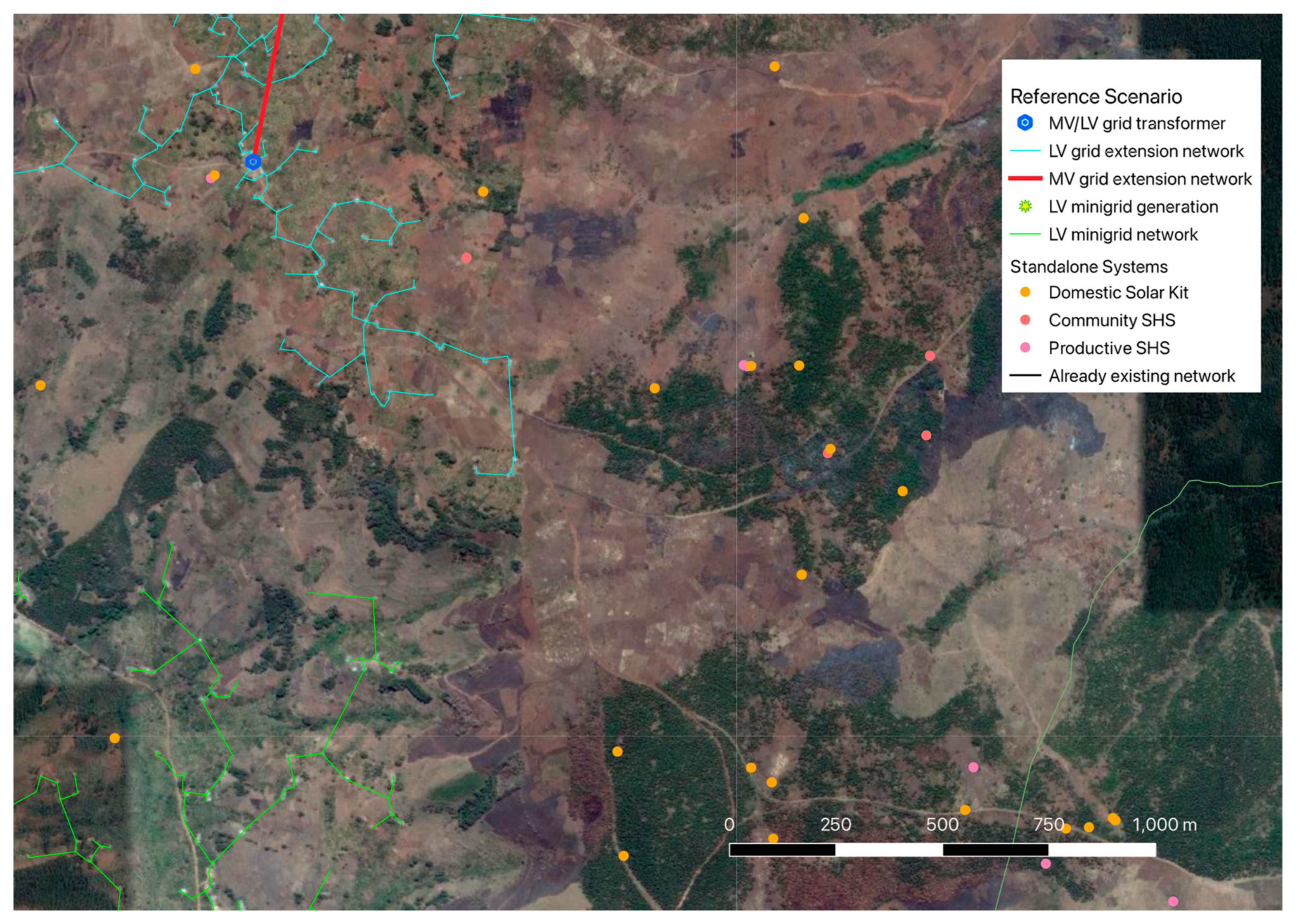
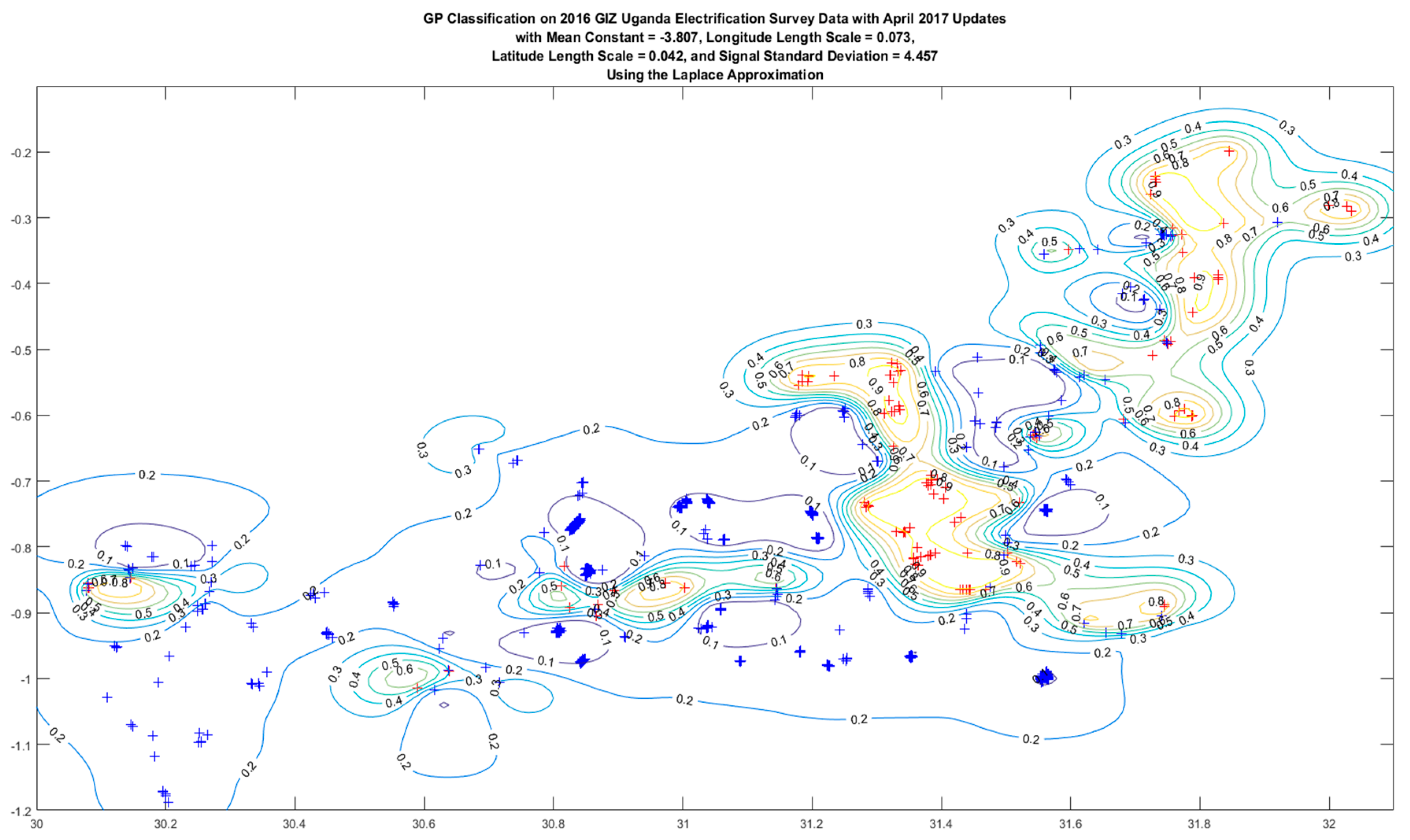
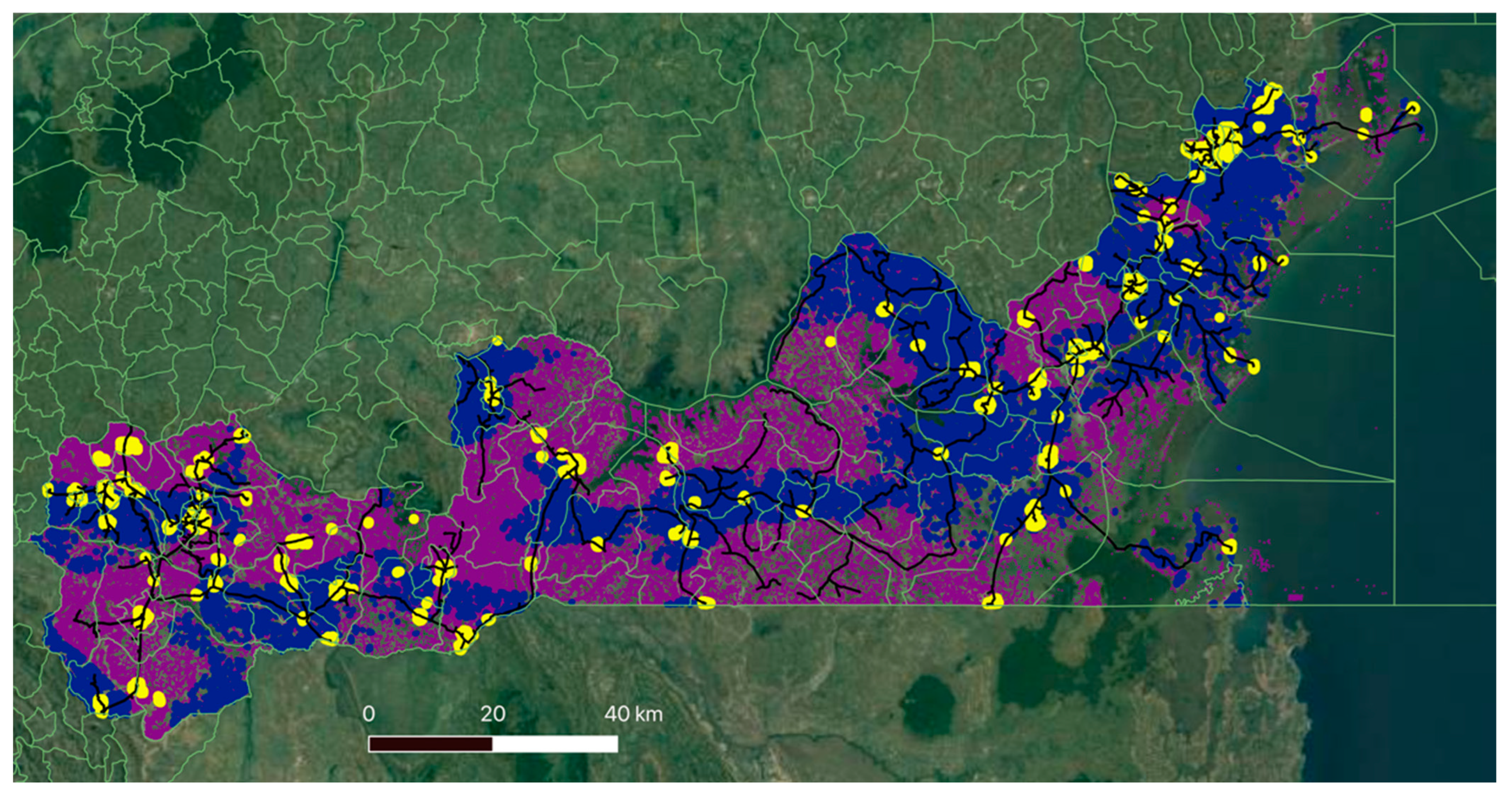
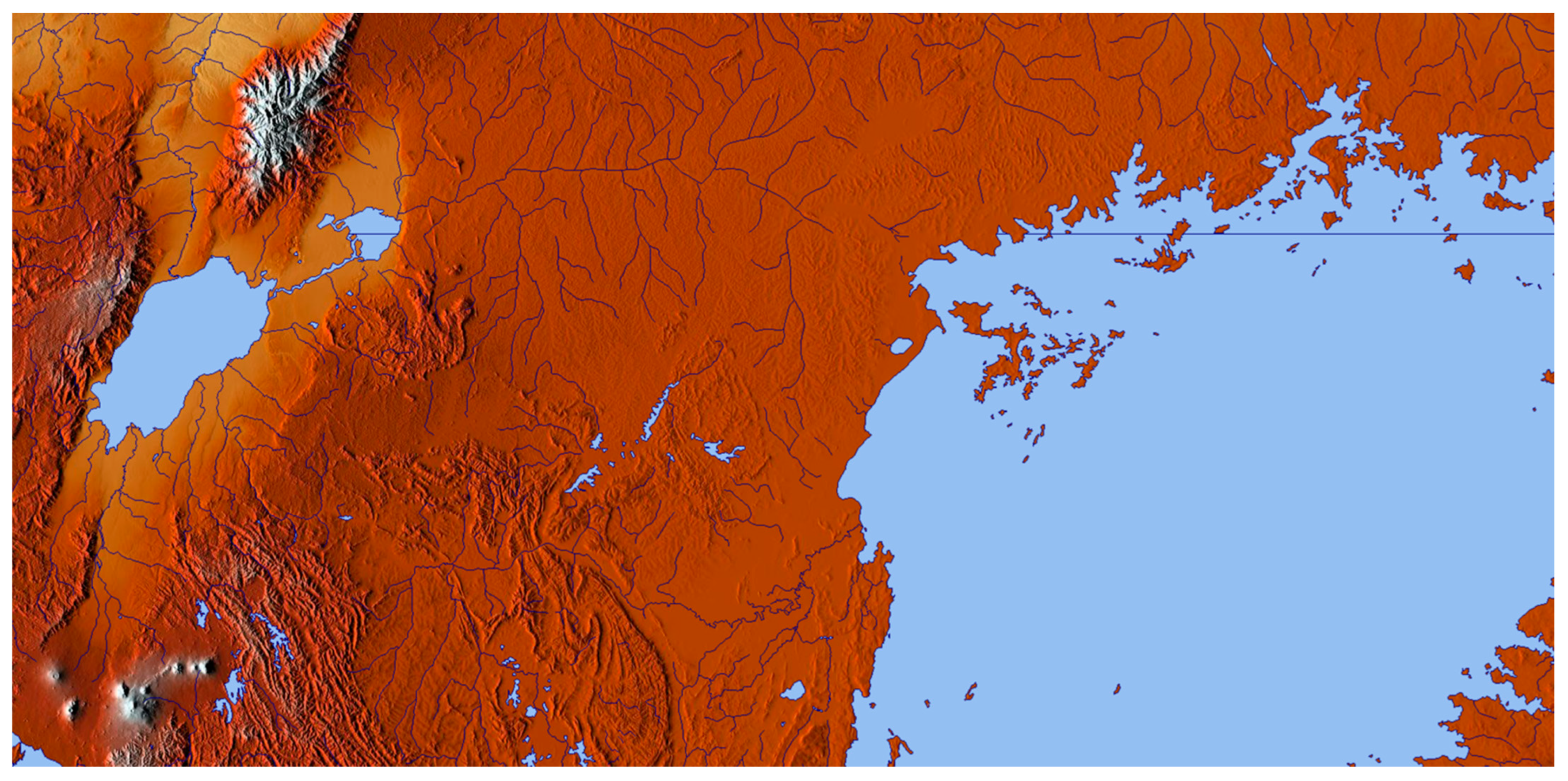

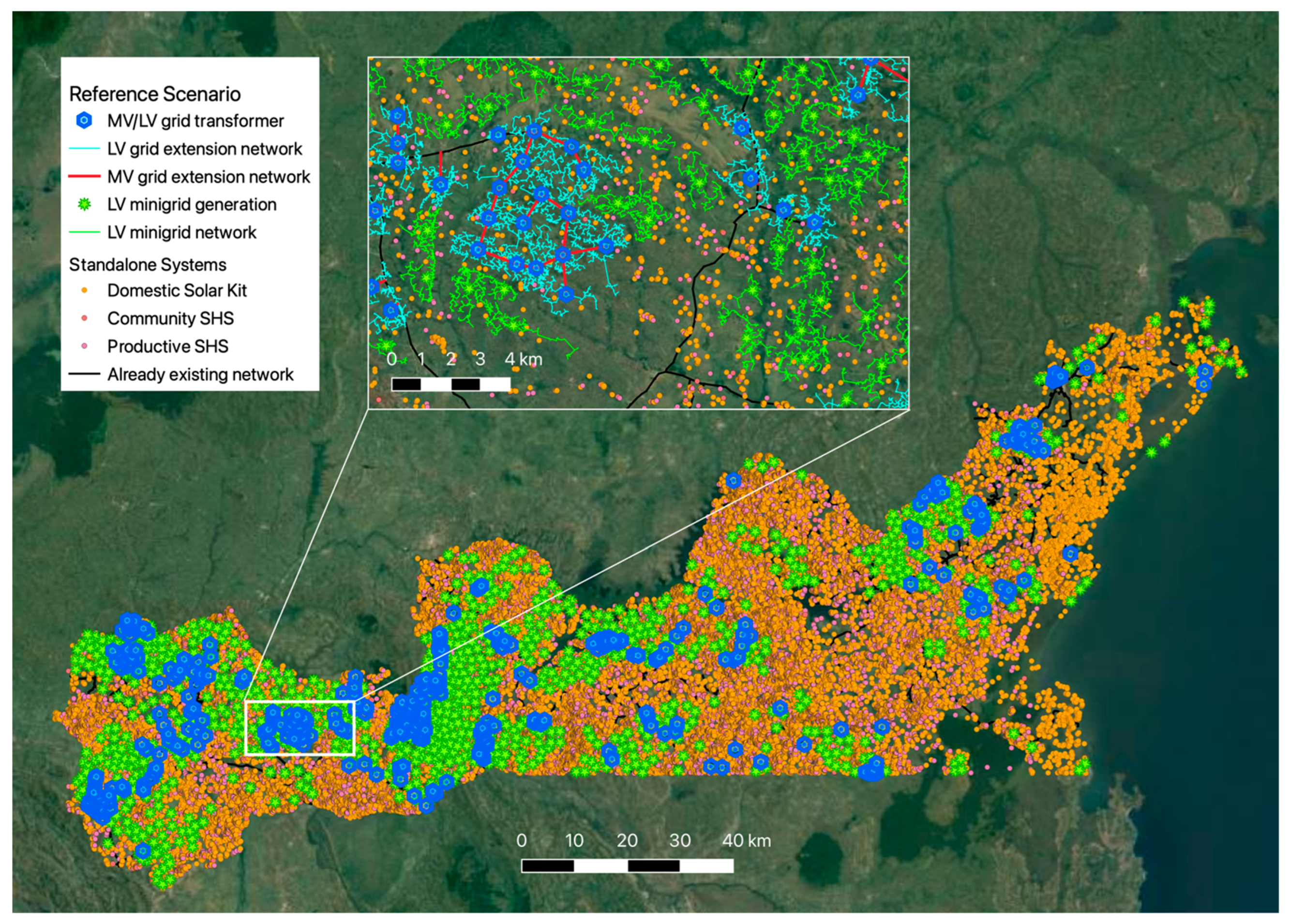

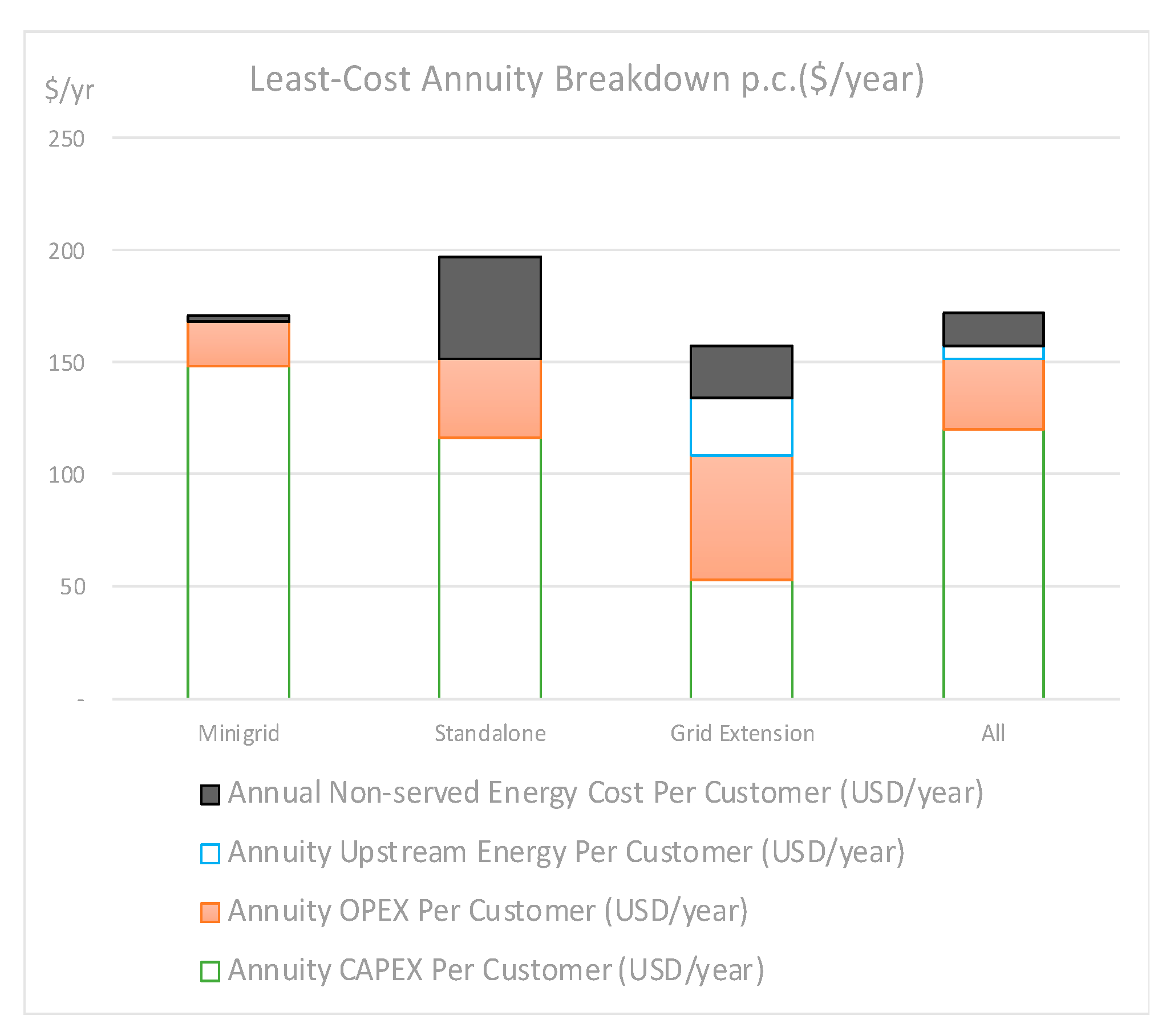
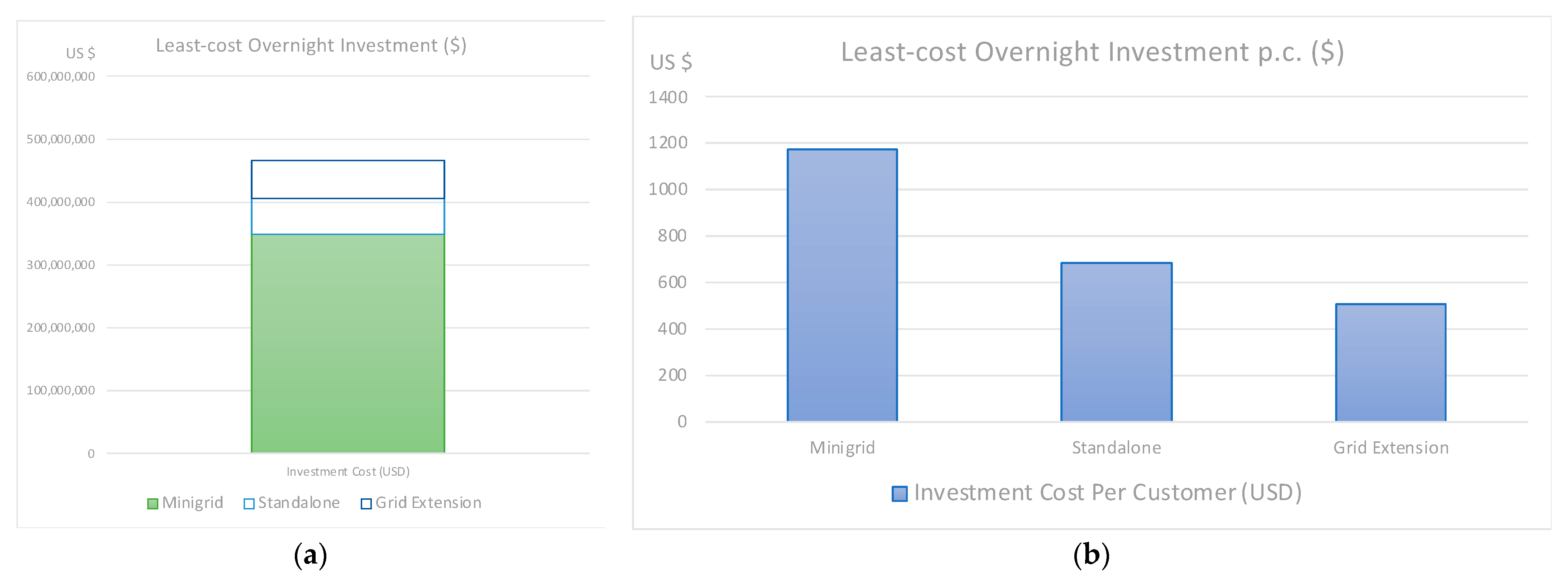
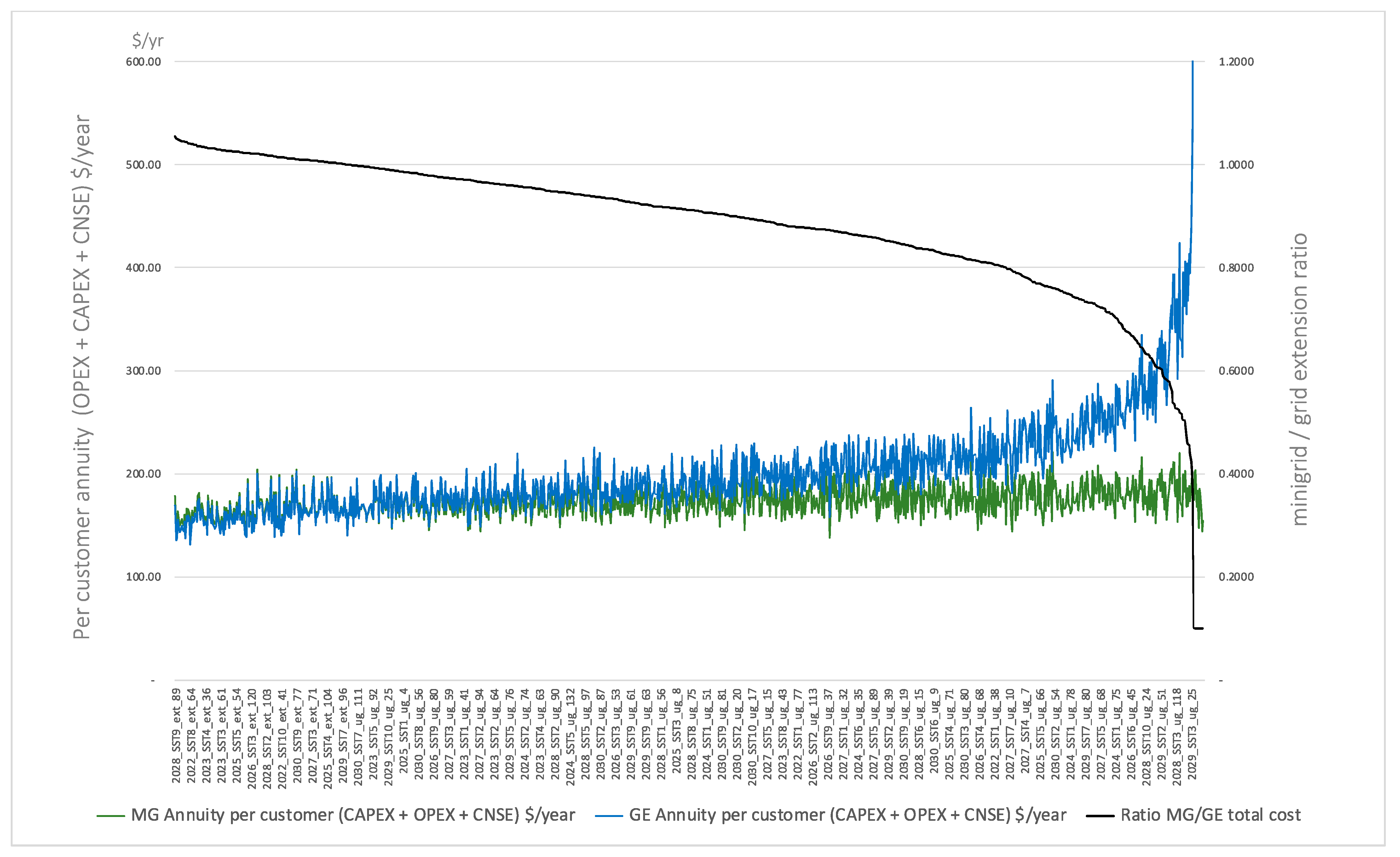
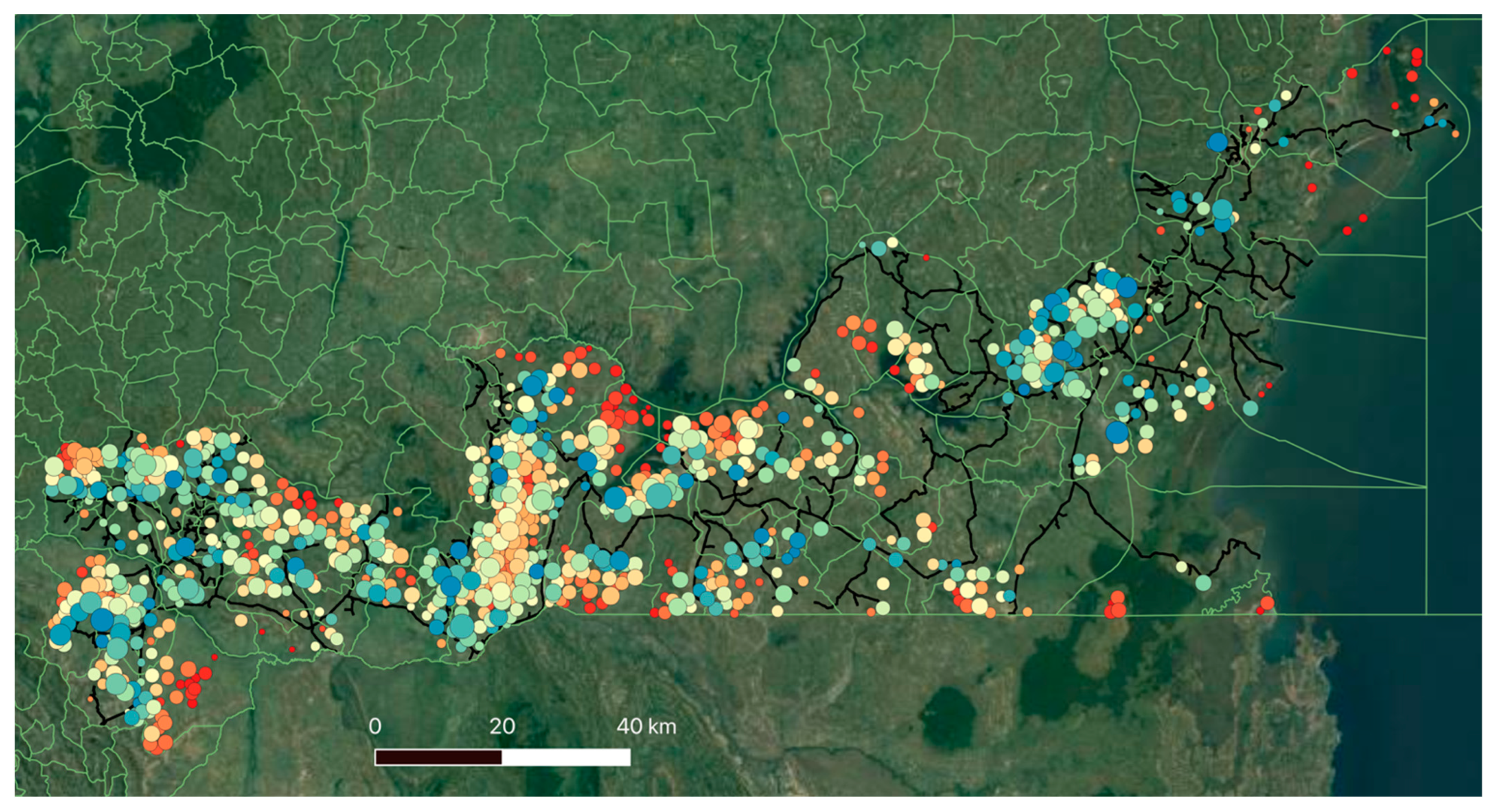

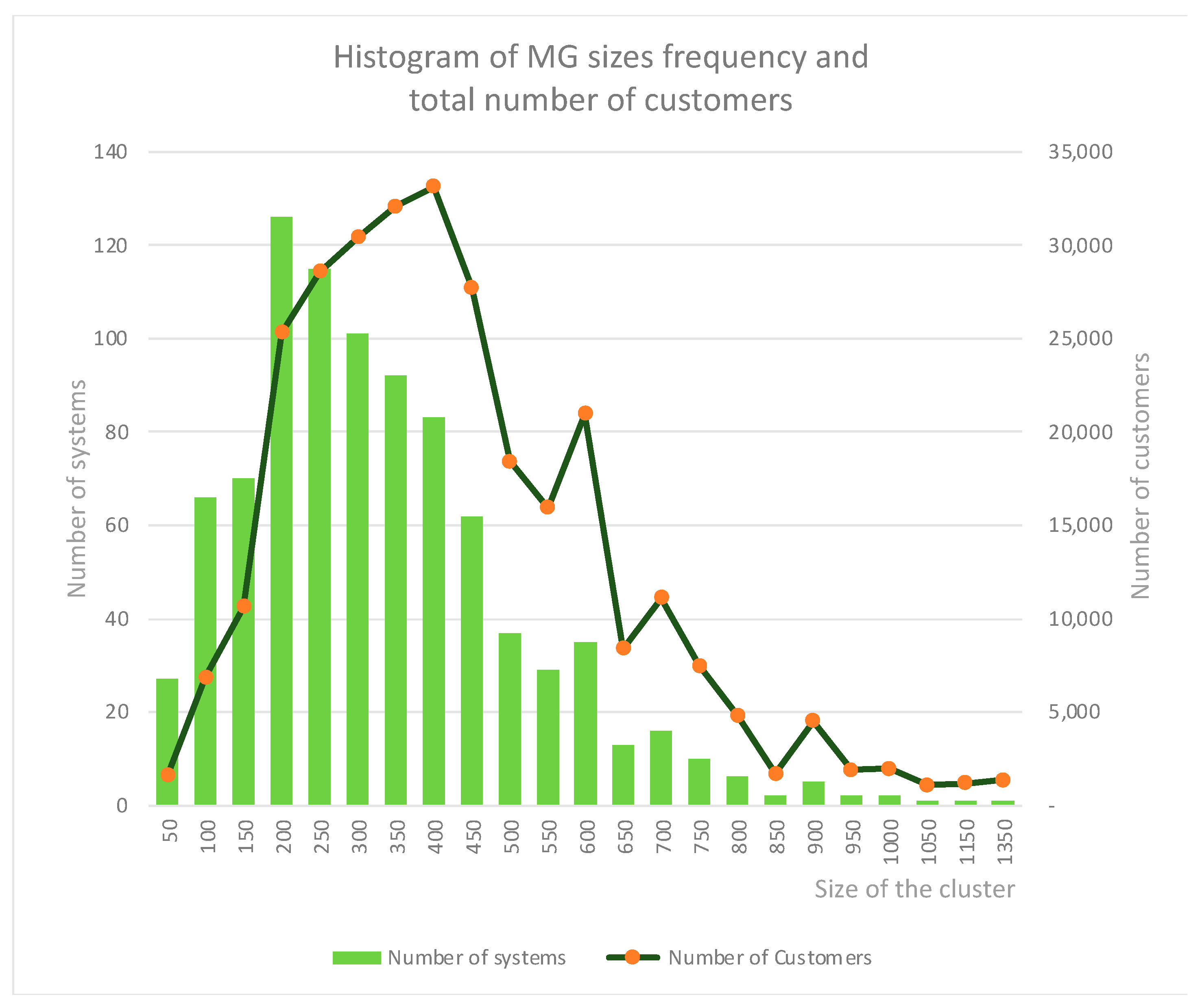
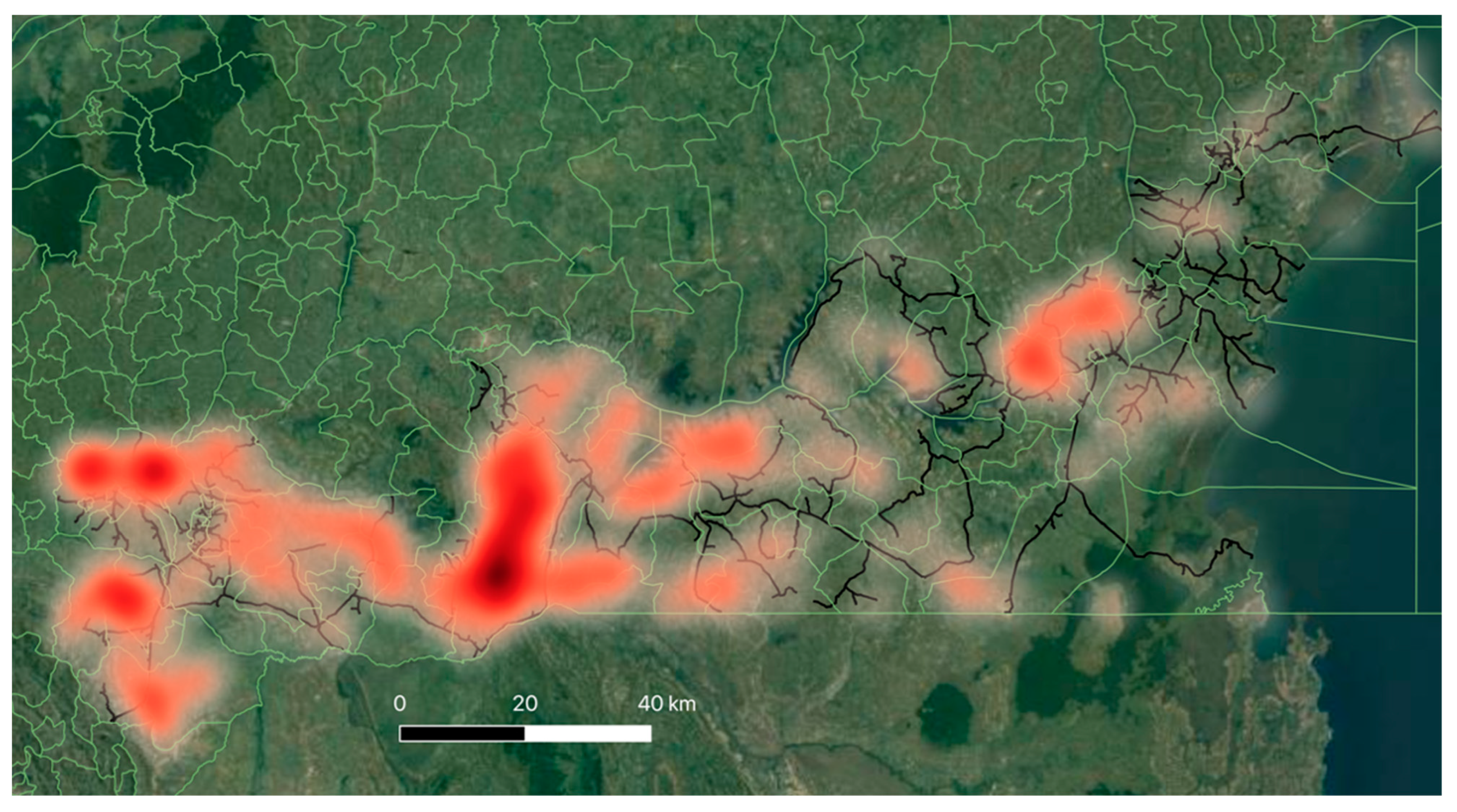
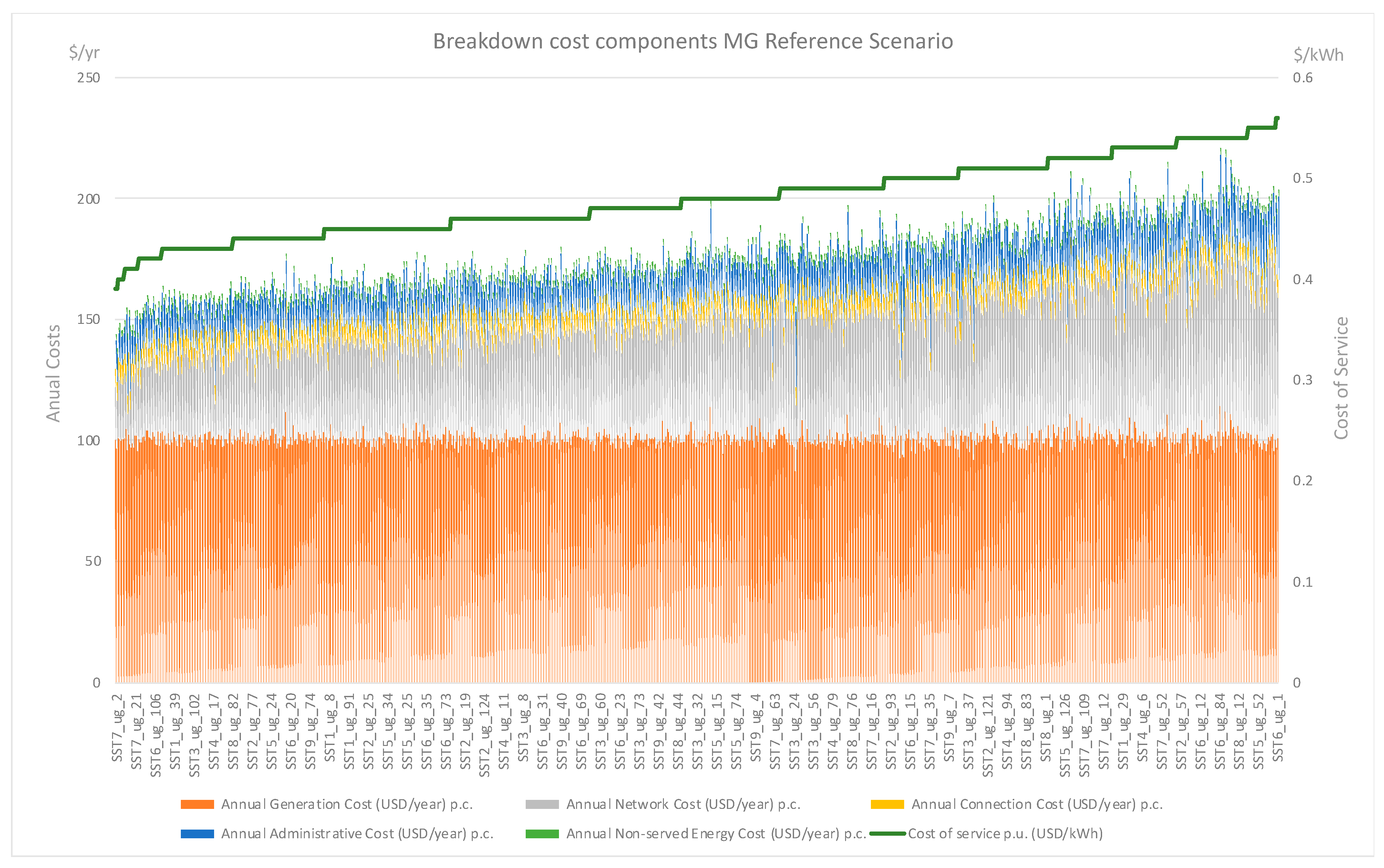

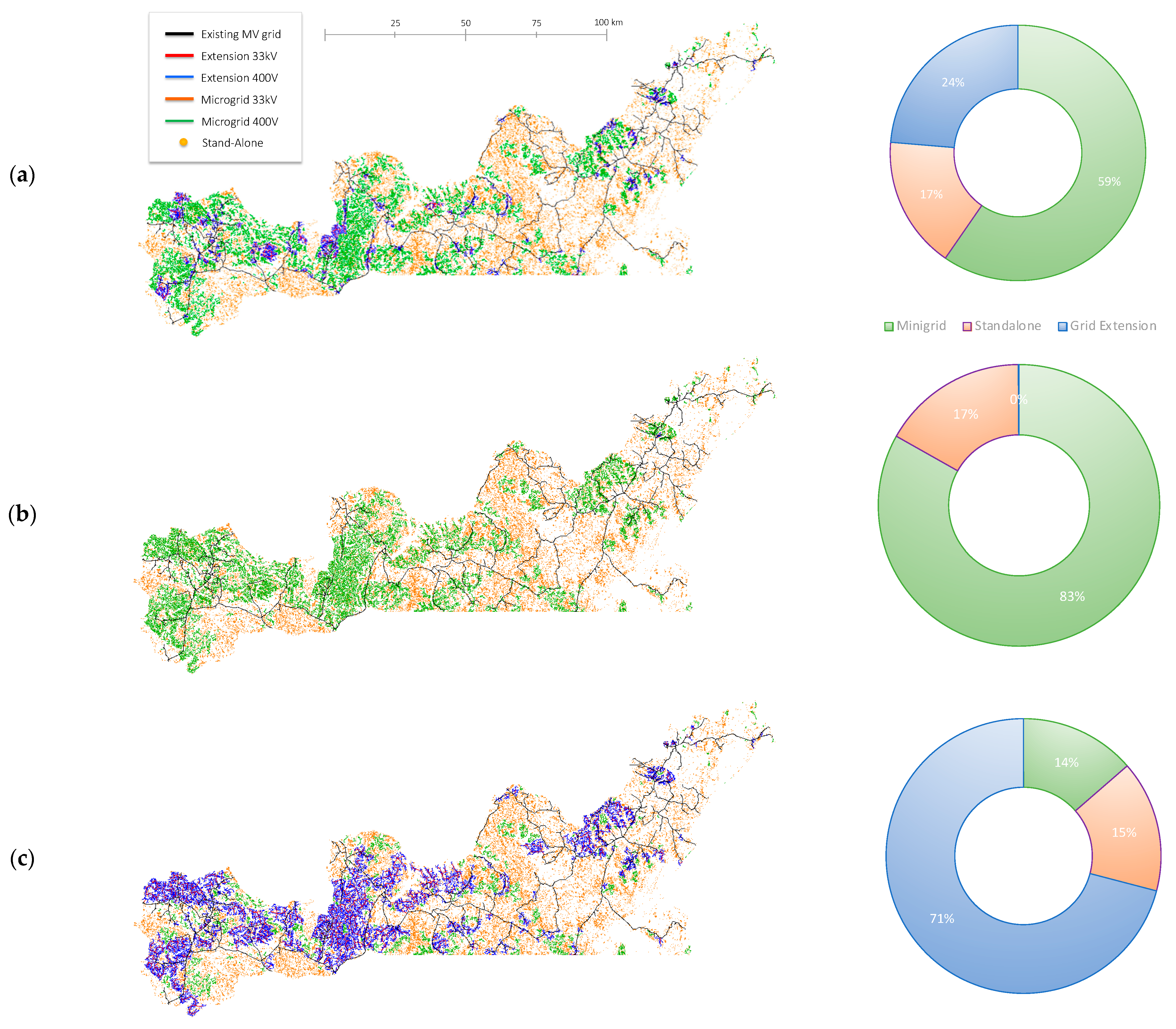
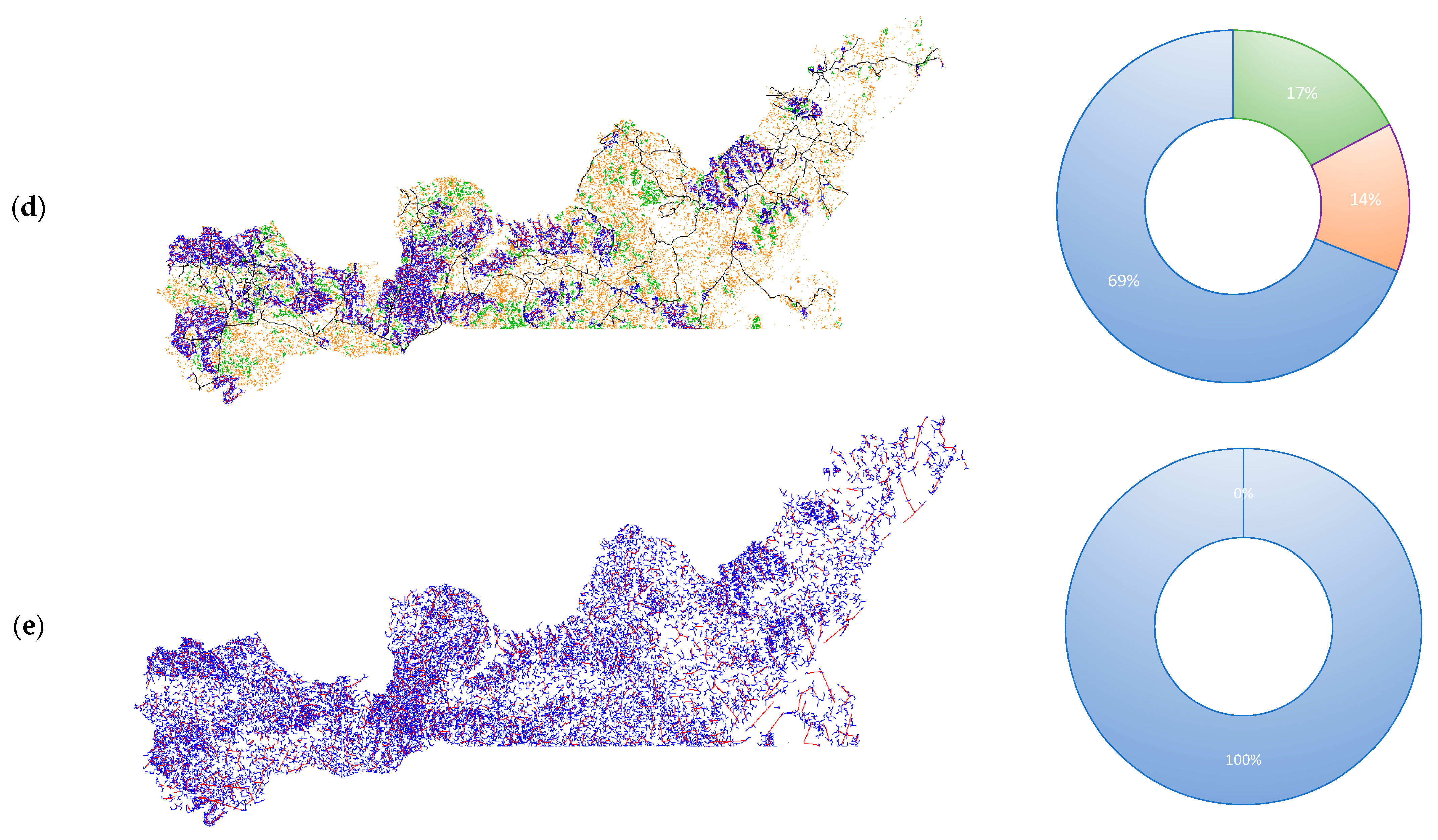



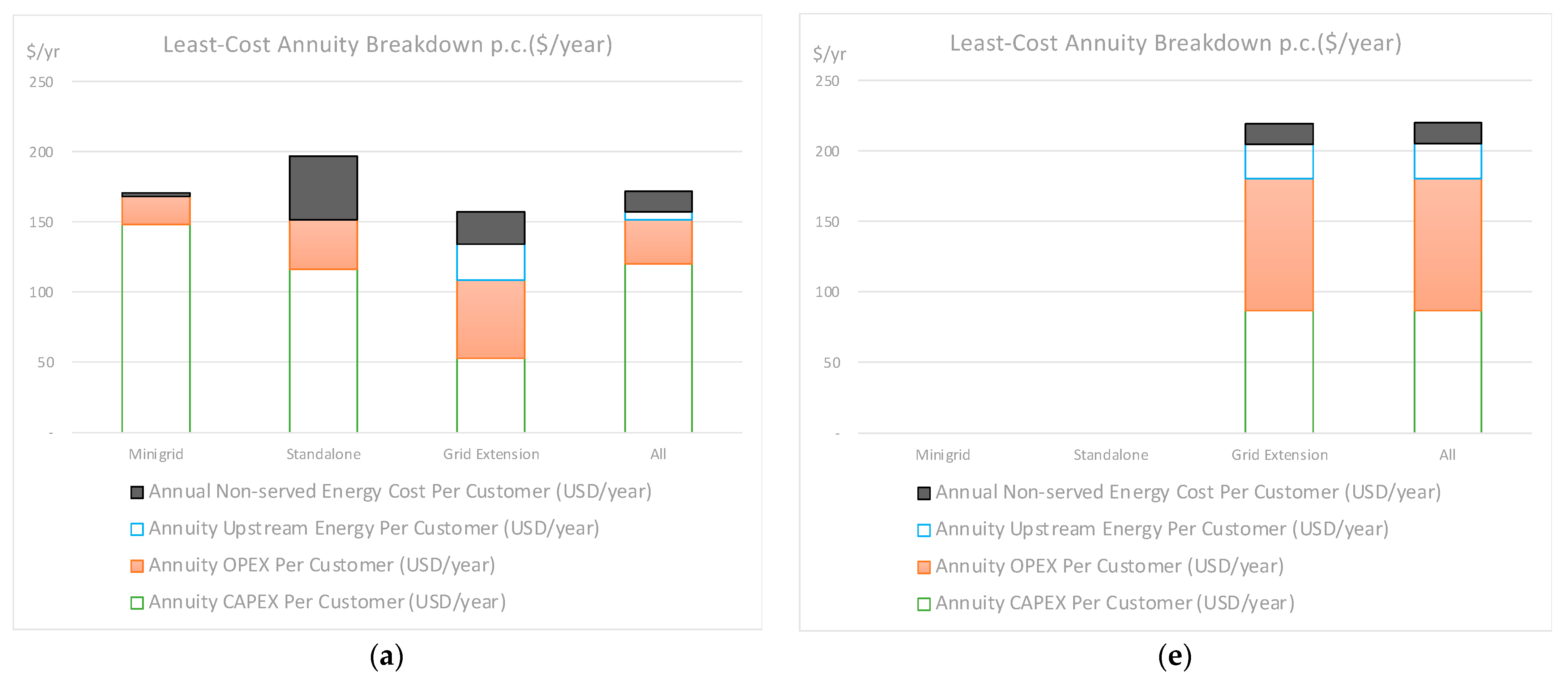
| Customer Types | Energy Demand | 2022 (kWh/year) | 2030 (kWh/year) |
|---|---|---|---|
| Residential | Non-critical | 62.86 | 75.25 |
| Critical | 158.31 | 189.51 | |
| Total | 221.17 | 264.76 | |
| Community | Non-critical | 0 | 0 |
| Critical | 696.39 | 833.63 | |
| Total | 696.39 | 833.63 | |
| Productive | Non-critical | 126.62 | 151.57 |
| Critical | 307.13 | 367.66 | |
| Total | 433.75 | 319.23 |
| Results Summary Uganda SST 90GREL | Minigrid | Standalone | Grid Extension | All |
|---|---|---|---|---|
| Number of Customers | 297,088 | 83,363 | 118,029 | 498,480 |
| Fraction of Customers | 59.60% | 16.72% | 23.68% | 100.00% |
| Annuity CAPEX Per Customer (USD/year) | 148.38 | 116.13 | 52.66 | 120.32 |
| Annuity OPEX Per Customer (USD/year) | 19.91 | 35.66 | 55.96 | 31.08 |
| Annuity Upstream Energy Per Customer (USD/year) | - | - | 25.50 | 6.04 |
| Annuity TOTEX Per Customer (USD/year) | 168.29 | 151.79 | 134.12 | 157.44 |
| Annual Non-served Energy Cost Per Customer (USD/year) | 2.65 | 45.46 | 23.46 | 14.74 |
| Total Annuity TOTEX (USD/year) | 49,996,850 | 12,653,619 | 15,830,026 | 78,480,495 |
| Total Non-served Energy Cost (USD/year) | 786,219 | 3,789,788 | 2,769,181 | 7,345,188 |
| Fraction of Demand Served (p.u.) | 98.70% | 82.80% | 90.00% | 94.00% |
| Cost Per kWh (Total Supply Cost) (USD/kWh) | 0.4680 | 0.5130 | 0.4090 | 0.4610 |
| Annual Energy (MWh/year) | 108,218.00 | 29,747.00 | 42,993.00 | 180,958.00 |
| Annual Energy Per Customer (kWh/year) | 364.26 | 356.84 | 364.26 | 363.02 |
| Investment Cost (USD) | 348,959,328 | 57,095,261 | 59,645,021 | 465,699,610 |
| Investment Cost Per Customer (USD) | 1174.60 | 684.90 | 505.34 | 934.24 |
Publisher’s Note: MDPI stays neutral with regard to jurisdictional claims in published maps and institutional affiliations. |
© 2022 by the authors. Licensee MDPI, Basel, Switzerland. This article is an open access article distributed under the terms and conditions of the Creative Commons Attribution (CC BY) license (https://creativecommons.org/licenses/by/4.0/).
Share and Cite
González-García, A.; Ciller, P.; Lee, S.; Palacios, R.; de Cuadra García, F.; Pérez-Arriaga, J.I. A Rising Role for Decentralized Solar Minigrids in Integrated Rural Electrification Planning? Large-Scale, Least-Cost, and Customer-Wise Design of Grid and Off-Grid Supply Systems in Uganda. Energies 2022, 15, 4517. https://doi.org/10.3390/en15134517
González-García A, Ciller P, Lee S, Palacios R, de Cuadra García F, Pérez-Arriaga JI. A Rising Role for Decentralized Solar Minigrids in Integrated Rural Electrification Planning? Large-Scale, Least-Cost, and Customer-Wise Design of Grid and Off-Grid Supply Systems in Uganda. Energies. 2022; 15(13):4517. https://doi.org/10.3390/en15134517
Chicago/Turabian StyleGonzález-García, Andrés, Pedro Ciller, Stephen Lee, Rafael Palacios, Fernando de Cuadra García, and José Ignacio Pérez-Arriaga. 2022. "A Rising Role for Decentralized Solar Minigrids in Integrated Rural Electrification Planning? Large-Scale, Least-Cost, and Customer-Wise Design of Grid and Off-Grid Supply Systems in Uganda" Energies 15, no. 13: 4517. https://doi.org/10.3390/en15134517
APA StyleGonzález-García, A., Ciller, P., Lee, S., Palacios, R., de Cuadra García, F., & Pérez-Arriaga, J. I. (2022). A Rising Role for Decentralized Solar Minigrids in Integrated Rural Electrification Planning? Large-Scale, Least-Cost, and Customer-Wise Design of Grid and Off-Grid Supply Systems in Uganda. Energies, 15(13), 4517. https://doi.org/10.3390/en15134517







